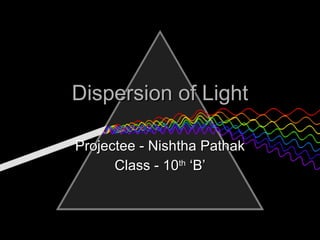Dispersion of light
•Transferir como PPT, PDF•
45 gostaram•46,831 visualizações
Denunciar
Compartilhar
Denunciar
Compartilhar

Mais conteúdo relacionado
Mais procurados
Mais procurados (20)
Destaque
Destaque (8)
Dispersion compensation in an optical fiber by using

Dispersion compensation in an optical fiber by using
Available online at [www.ijeete.com]EFFECT OF DISPERSION AND FIBER LENGTH ON ...![Available online at [www.ijeete.com]EFFECT OF DISPERSION AND FIBER LENGTH ON ...](data:image/gif;base64,R0lGODlhAQABAIAAAAAAAP///yH5BAEAAAAALAAAAAABAAEAAAIBRAA7)
![Available online at [www.ijeete.com]EFFECT OF DISPERSION AND FIBER LENGTH ON ...](data:image/gif;base64,R0lGODlhAQABAIAAAAAAAP///yH5BAEAAAAALAAAAAABAAEAAAIBRAA7)
Available online at [www.ijeete.com]EFFECT OF DISPERSION AND FIBER LENGTH ON ...
Performance Analysis of Dispersion Compensation in Long Haul Optical Fiber wi...

Performance Analysis of Dispersion Compensation in Long Haul Optical Fiber wi...
Dispersion Compensation Techniques for Optical Fiber Communication

Dispersion Compensation Techniques for Optical Fiber Communication
Semelhante a Dispersion of light
Prism. prepared by T.Sivaramakrishnan { elc president },Aditya vidyashram res...

Prism. prepared by T.Sivaramakrishnan { elc president },Aditya vidyashram res...RotechSrkSivaramakri
Semelhante a Dispersion of light (20)
Prism. prepared by T.Sivaramakrishnan { elc president },Aditya vidyashram res...

Prism. prepared by T.Sivaramakrishnan { elc president },Aditya vidyashram res...
Physics 7 - Light (characteristics, properties, kinds and types of light)

Physics 7 - Light (characteristics, properties, kinds and types of light)
Último
TỔNG ÔN TẬP THI VÀO LỚP 10 MÔN TIẾNG ANH NĂM HỌC 2023 - 2024 CÓ ĐÁP ÁN (NGỮ Â...

TỔNG ÔN TẬP THI VÀO LỚP 10 MÔN TIẾNG ANH NĂM HỌC 2023 - 2024 CÓ ĐÁP ÁN (NGỮ Â...Nguyen Thanh Tu Collection
Mehran University Newsletter Vol-X, Issue-I, 2024

Mehran University Newsletter Vol-X, Issue-I, 2024Mehran University of Engineering & Technology, Jamshoro
Último (20)
TỔNG ÔN TẬP THI VÀO LỚP 10 MÔN TIẾNG ANH NĂM HỌC 2023 - 2024 CÓ ĐÁP ÁN (NGỮ Â...

TỔNG ÔN TẬP THI VÀO LỚP 10 MÔN TIẾNG ANH NĂM HỌC 2023 - 2024 CÓ ĐÁP ÁN (NGỮ Â...
Mixin Classes in Odoo 17 How to Extend Models Using Mixin Classes

Mixin Classes in Odoo 17 How to Extend Models Using Mixin Classes
Unit-V; Pricing (Pharma Marketing Management).pptx

Unit-V; Pricing (Pharma Marketing Management).pptx
HMCS Max Bernays Pre-Deployment Brief (May 2024).pptx

HMCS Max Bernays Pre-Deployment Brief (May 2024).pptx
Python Notes for mca i year students osmania university.docx

Python Notes for mca i year students osmania university.docx
Dispersion of light
- 1. Dispersion of Light Projectee - Nishtha Pathak Class - 10 th ‘B’
- 10. Lets Find Out More Facts
